Av Receivers That Are Easy to Set Up
An audio-video (AV) receiver is the quarterback of your home theater. It's not just because information technology tells everything where to become, routing signals to different speakers and screens. Information technology's because a good quarterback makes the team ameliorate - and a good receiver will bring the best out of your home theater speakers. The market place is a crowded one, so we've picked out some of the best AV receivers for this year for y'all to choose from - whatsoever your budget, or room size. When making this list, we chose to only include receivers that accept the ability to power speakers. You lot won't find any surround audio processors or preamps here – just total, integrated AV receivers. For more than background, see our AV receiver comparison table and buying advice below the picks.
Our AV Receiver Picks:
- Best Overall AV Receiver: Denon AVR-S960H
- All-time Upkeep AV Receiver:Sony STR-DH590
- All-time Receiver for Wireless Surround:Yamaha RX-V485
- Best AV Receiver for Dolby Atmos:Denon AVR-X3700H
- Best High-End AV Receiver: NAD T 778
- A Great AV Receiver for Music:Denon AVR-S750H
- All-time AV Receiver With Sonos:Integra DRX-3.3
Best Overall AV Receiver
1. Denon AVR-S960H ($850)
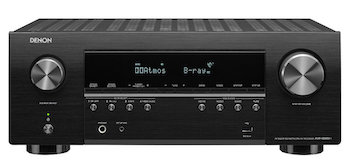 Channels: 7.2
Channels: 7.2
Dolby Atmos: Yes
DTS:X: Yes
Wattage Per Channel: xc/8Ω, Two-Channels Driven
What We Like: Powerful, muscular sound matched with terrific features.
What Nosotros Don't: There's no Chromecast, and the HEOS app can be annoying.
In our opinion, anybody looking to purchase the accented all-time overall AV receiver for the money needs to purchase a Denon—and in particular, the AVR-S960H. It truly is one of the finest receivers we've ever tested, impressing us with hard-hitting, muscular audio. It smokes any other receiver here, beating out competing models from Sony and Yamaha hands. It has a wealth of useful features, including Dolby Atmos and DTS:X surroundings sound, Bluetooth, and Spotify Connect for music listening. With its killer sound and feature prepare, the AVR-S960H is easily the best receiver you tin buy.
One feature that nosotros would similar to see added to the Denon AVR-S960H is Chromecast. This is a surprising omission, and it's fabricated even more annoying when you consider that HEOS, Denon'south own streaming app, is clunky and frustrating to utilise. But you can easily operate the AVR-S960H without information technology. Nosotros much adopt this receiver to models similar the Yamaha RX-485, below, and even Denon'due south other offerings. It genuinely is 1 of the best models yous can purchase.
See the Denon AVR-S960H
Best Upkeep AV Receiver
2. Sony STR-DH590 ($278)
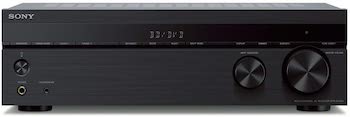 Channels: 5.1
Channels: 5.1
Dolby Atmos: No
DTS:X: No
Wattage Per Channel: 145/6Ω, Two-Channels Driven
What We Similar: Offers a lot for the toll, with practiced audio and features.
What Nosotros Don't: Non really suited to floorstanding speakers.
If y'all are a beginner in the world of dwelling theater and environment audio, the Sony STR-DH590 is the receiver to go for. It gives you all the features y'all'll need to get started with a basic surroundings speaker setup, and draws its wealth of features from its bigger blood brother, the bestselling STR-DN1080, featured beneath. You go five speaker channels, allowing you lot to use speakers at the side or rear, and in that location's total 4K passthrough so yous can get the very best out of your moving picture. The sound quality is solid, too. While other receivers like the $299 Denon AVR-S540BT have a footling more sonic weight to them, the STR-DH590 delivers great precision and detail.
One of the things to conduct in mind with the Sony STR-DH590 is that it doesn't play well with bigger floorstanding or belfry speakers. It only doesn't take the finesse or ability to drive them effectively, meaning you'll go subpar audio. If you lot go for this receiver, we recommend smaller satellite or bookshelf speakers. Just really, that'southward one of the few downsides. If you're on a upkeep, or looking to dip your toe into surround sound, the STR-DH590 is one of the easiest means to start.
See the Sony STR-DH590
All-time Receiver for Wireless Surround Speakers
3. Yamaha RX-V485 ($450)
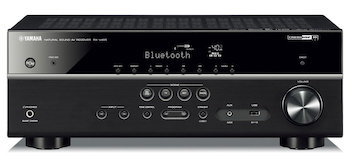 Channels: 5.1
Channels: 5.1
Dolby Atmos: No
DTS:X: No
Wattage Per Channel: 80/8Ω, Two-Channels Driven
What We Like: Easy and affordable wireless functionality via Yamaha's solid MusicCast software.
What We Don't: Limited HDMI ports, and other receivers have better sound.
In the globe of home theater, there are several options for incorporating wireless environs speakers and avoiding pesky speaker wire. Sonos, Denon and Yamaha are the top contenders, simply receivers with Sonos functionality are expensive, and Denon'due south HEOS tech doesn't always work well. Yamaha's RX-V685 receiver incorporates their MusicCast software, which makes information technology like shooting fish in a barrel to use uniform Yamaha speakers for environs sound. Wireless home theater can be very expensive or finicky, but fortunately, the RX-V685 is the polar opposite. It also happens to exist a solid receiver in its own right, with adept sound. Although it lacks Dolby Atmos functionality, its affordability and convenience more make upwardly for it.
If the RX-V485 has 1 major downside, information technology's that information technology only has four HDMI ports. While they tin all handle 4K video playback, four isn't very much – if you plan to add more sources later, this may pose a problem. We also argue that other similarly-priced receivers, like the $849 Denon AVR-S960H, offering improve sound quality. But ultimately, we've picked the Yamaha because information technology does wireless audio effectively, at a much more affordable cost than its competitors. There is a newer model, the V685, but we've seen its availability fluctuate, and it's not a pregnant jump from its predecessor.
See the Yamaha RX-V485
Best AV Receiver for Dolby Atmos Surround Sound
4. Denon AVR-X3700H ($1,599)
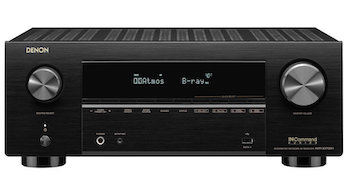 Channels: 11.2
Channels: 11.2
Dolby Atmos: Yes
DTS:10: Yes
Wattage Per Channel: 105/8Ω, Two-Channels Driven
What We Like: A terrific update that improves the audio quality, boasts plenty of clever features.
What We Don't: Does best in larger rooms, won't perform as well in smaller spaces.
All of the receivers on our list tin exercise surround sound. But doing it well is a different story, and doing Dolby Atmos (in our opinion, the best you can go correct at present) well is even more challenging. That'southward why nosotros call back the Denon AVR-X3700H is the best pick if you need the ultimate in surround sound. It's not simply that it gives you all the features you need, including a range of codecs; that's a given. Information technology's that present sound quality that really emphasises the individual channels, and lifts out the detail, punch, and clarity. We tested pricey models from other brands like Marantz too, but this receiver was a clear winner. Worth noting: to actually get the best out of the AVR-X3700H's audio, you'll require a large room that measures over 400 square anxiety, which might not exist possible for some.
The one large downside with the Denon AVR-X3700H is that it offers (in fact, all but trumpets) 8K compatibility. Which you're paying for. And right now, there'due south just not enough 8K content around to justify the extra expense. You tin can save some coin by finding the older AVR-X3600H, merely that's becoming much trickier these days. Every bit and when 8K content becomes a big deal, we'll reevaluate this. For now though, the AVR-X3700H remains a stellar selection for surround audio.
Meet the Denon AVR-X3700H
All-time High-Cease AV Receiver
5. NAD T 778 ($iii,199)
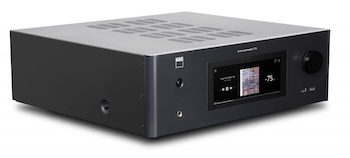 Channels: 9.2
Channels: 9.2
Dolby Atmos: Yes
DTS:X: No
Wattage Per Channel: 110/8Ω, Two-Channels Driven
What We Like: Finally someone redesigns the AV receiver.
What Nosotros Don't: The loftier cost makes it inaccessible for most.
I thing you may have noticed with our list, even if you're only moderately alert, is that virtually all the receivers look the same. Same design, same control schemes, identikit names. Don't blame us; blame the industry. Which is why the NAD T 778 is such a breath of fresh air. It's the first receiver nosotros've seen that really looks cool, incorporating NAD'due south excellent touchscreen technology and a vivid, bright brandish. This brand-new receiver sounds stupendous, with a stunning range of features, and is a highly competitive alternative to the likes of the Arcam AVR20. Of all the four-effigy monsters hither, the NAD T 778 is the most interesting and exciting.
The high toll may brand people interruption, however. The T 778 is one of the most expensive receivers on this listing, and given the touchscreen tech and the stunning range of features, that's hardly surprising. Nevertheless, it'south out of reach for most people, which makes it hard to recommend that everybody buy it. There are also some puzzling omissions, similar the lack of DTS:X – all you become is DTS Main Audio.
See the NAD T 778
A Great AV Receiver for Music
6. Denon AVR-S750H ($699)
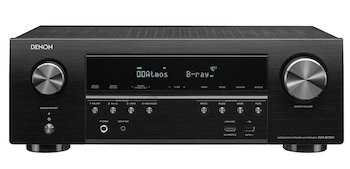 Channels: vii.2
Channels: vii.2
Dolby Atmos: Yes
DTS:X: Yes
Wattage Per Channel: 90/8Ω, Two-Channels Driven
What We Like: Significant price drop makes this incremental update worthwhile.
What We Don't: Lacks some features, and has an outdated interface.
Previously, we would have advised confronting the Denon AVR-S750H. It was an incremental update on the 740H, and toll about $200 more than. But the price dropped recently to a much more affordable $577, so we think we tin can recommend information technology over its older brother. It'southward an excellent receiver, with a huge range of features and warm, engaging sound quality, specially for music. You tin can add together wireless speakers via Denon's HEOS functionality (although the less-expensive Yamaha RX-V485 is a better option for this) and there are clever features like Apple tree AirPlay two and smart assistants included.
Notwithstanding, information technology is features where the Denon AVR-S750H struggles. As good a receiver as it is, it'south a real puzzle that it doesn't accept Google ChromeCast, which most other receivers to a higher place it in this listing have. Nosotros besides accept to give information technology a black marking for the on-screen interface, which is hugely clunky and outdated. While these bug mean that the Denon AVR-S750H isn't the best, it'southward still a very good ane overall, and easily the best for Spotify listening.
Encounter the Denon AVR-S750H
All-time AV Receiver With Sonos
vii. Integra DRX-3.3 ($999)
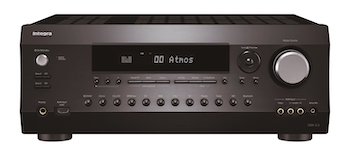 Channels: 9.ii
Channels: 9.ii
Dolby Atmos: Yeah
DTS:10: Yeah
Wattage Per Aqueduct: xc/8Ω, 2-Channels Driven
What Nosotros Like: Clean Sonos integration makes wireless speaker audio a breeze.
What We Don't: We think it's overpriced right now.
Sonos speakers a hugely popular, and with expert reason: when it comes to wireless audio, they are among the easiest and best sounding options available. Their products are slowly becoming more than and more than integrated with AV receivers, and we think the Integra DRX-3.3 does the best job here. It easily allows you to link existing Sonos speakers to it, too as play any audio through the Sonos Connect app. If you ain speakers from the company, and you desire to integrate them into a compelling home theater setup, and then the DRX-3.3 is the all-time way to do information technology in our opinion.
The problem is, Sonos integration aside, the Integra DRX-3.three doesn't practise anything especially special. Other less expensive receivers, like the $649 Denon AVR-S960H, arguably offer better audio quality. And since we are talking about price, information technology must be said that the DRX-three.3 is quite expensive for what you get. It'southward a smashing option for Sonos integration, but it definitely has its downsides.
See the Integra DRX-3.3
Best of the Rest
8. Denon AVR-S540BT ($349)
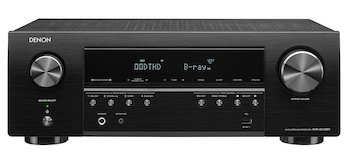 Channels: five.two
Channels: five.two
Dolby Atmos: No
DTS:X: No
Wattage Per Channel: 70/8Ω, Two-Channels Driven
What We Like: Good audio quality, room for ii subwoofers.
What We Don't: Outdated design features, like bound clips for speaker wire.
We are e'er very conscientious about recommending receivers under $400, equally they can be striking and miss. The Denon AVR-S540BT, fortunately, is the former. It may be parsimonious with features, peculiarly when compared to models like the $278 Sony STR-DH590, our top budget pick. But it makes up for it with solid sound quality that has real punch and pizzazz. We likewise like the fact that it'southward a 5.2 organization, meaning information technology can handle twin subwoofers—a rarity at this price point. If yous're a bass caput, the AVR-S540BT could be a slap-up pick.
The most glaring downsides, in our stance, are the dated pattern and the lack of features. The Denon AVR-S540BT may offer proficient sound, but it uses bound clips for speaker wire attachment, as opposed to the more common and much friendlier bounden posts. That makes it fiddly and irritating to setup, although it's forgiveable at this price point. And compared to other budget receivers, hither, the AVR-S540BT loses out big fourth dimension. It offers only Dolby TrueHD and DTS Hard disk Principal surround sound, which are very limited options. We like it for pure sound quality, just information technology's far from the best receiver here.
Run into the Denon AVR-S540BT
9. Sony STR-DN1080 ($1,013)
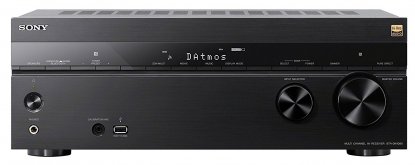 Channels: seven.2
Channels: seven.2
Dolby Atmos: Yes
DTS:Ten: Yeah
Wattage Per Channel: Unknown
What Nosotros Like:Terrific sound and user interface.
What We Don't: Doesn't quite compete with bigger models.
Several other sites place the STR-DN1080 at the height of their lists. We are not several other sites. While we think information technology'south solid – specially for the price range – it doesn't quite go the edge over the Yamaha RX-V685. All the same, it'southward got excellent sound quality, not to mention power: 165 watts, which is more than plenty to power just about any speaker currently on the market. And it easily beats out the similarly priced Denon AVR-S750H, beneath, in most categories. In that location'south only really one exception, which is Amazon Alexa functionality. The Denon has it; the Sony does not. You may want to take that into consideration earlier ownership.
We also dearest Sony's interface, which continues from the i present on the old 1060, and is very easy to use. We appreciate the fact that it not just has Dolby Atmos and DTS:X functionality (not normally seen at this toll range) but besides DSD functionality. That means it can play ultra-high-resolution sound files; a overnice touch, and not one yous come across frequently. Here's to the…1090? 1100? What we wouldn't give for some original receiver names…
See the Sony STR-DN1080
10. Sony STR-DH790 ($440)
 Channels: vii.2
Channels: vii.2
Dolby Atmos: Yes
DTS:X: Yeah
Wattage Per Channel: 145/6Ω, Two-Channels Driven
What We Similar: Solid audio quality.
What We Don't: Spring clip speaker terminals? Is this a joke?
The Sony STR-DH790 is the bigger brother of the DH590, which is currently our top budget pick for receivers. Yes, y'all'll pay a petty more money, but yous get significantly better sound quality, especially with movie dialogue. You become a very proficient range of features, as well: Dolby Atmos, DTS:X, and two more channels (plus an additional subwoofer output). If you're looking for surround sound, just aren't willing to spend $one,200 on a Denon AVR-X3700H, then this Sony will do merely fine.
But boy, does the Sony STR-DH790 make some strange design choices. The speaker terminals, for example. The front left and front right are regular terminals that allow convenient assistant plug connections, but all the others are basic spring clips that but accept blank speaker wire. That is stupendously annoying, and not something we'd look when spending almost $500. This is a practiced receiver, but it's non our kickoff choice.
See the Sony STR-DH790
11. Marantz NR1711 ($999)
 Channels: 9.2
Channels: 9.2
Dolby Atmos: Yes
DTS:X: Yeah
Wattage Per Channel: 110/8Ω, 2-Channels Driven
What We Similar: Offers a solid range of features, including HDMI 2.i and Dolby Atmos.
What Nosotros Don't: We retrieve it's overpriced right now.
The Marantz NR1711 is the latest in the current tendency of slimline receivers—a welcome trend, we might add. It's a sleek, attractive receiver that really wows on features. There'south 8K compatibility (although there's scant content right now that can take advantage of it), HDMI ii.1, and crucially, Variable Refresh Rate. That'southward important for new consoles like the XBox Series Ten and PS5, making this receiver a great option if yous programme on picking one of those up.
That said, the big downside here is that the Marantz NR1711 is overpriced right now. A pilus under $800 feels like a lot, specially when y'all take into account the sound quality, which is good rather than great. Marantz do honey their incremental updates, so hopefully newer models volition see this 1 drib in price. Nonetheless, correct at present, it'south merely worth considering if you're a gamer and want to go the absolute best out of your XBox or PS5. Because exterior of the the
Run across the Marantz NR1711
12. Pioneer SC-LX904 ($ii,999)
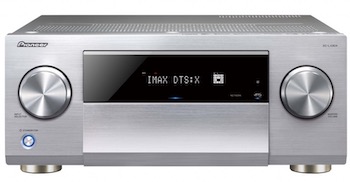 Channels: eleven.ii
Channels: eleven.ii
Dolby Atmos: Aye
DTS:X: Yep
Wattage Per Channel: 140/8Ω, Two-Channels Driven
What We Like: Incredible sound and ability at a surprisingly affordable price point.
What We Don't: Only worth the cost if you plan to use advanced music features.
Nosotros previously featured the Canticle MRX1120 at this spot on the listing, but we've found an alternative that does what the MRX1120 does, for about $500 less. The Pioneer SC-LX904 may have a higher price than some are willing to spend, merely information technology delivers absolutely epic sound. It has a huge amount of power at 140 watts, and the included surround audio software makes information technology a perfect option for big rooms. Information technology's non quite equally skilful as the Denon AVR-X8500H, simply information technology'south also almost $1,000 cheaper. That makes it a superb second banana.
Still, in that location'southward no escaping the fact that the majority of the cost goes towards the advanced music features of this model. If y'all enjoy playing music through your receiver, the Pioneer SC-LX904 has y'all covered. This model includes features similar multiroom audio, Sonos compatibility, and even compatibility with high-end music software similar Roon. These options are great to take, but if all you lot're doing is ownership a receiver for your dwelling theater setup, y'all'll be wasting your money hither. Regardless, the SC-LX904 does exactly what it's supposed to, at a very good price.
See the Pioneer SC-LX904
thirteen. Onkyo TX-NR686 ($700)
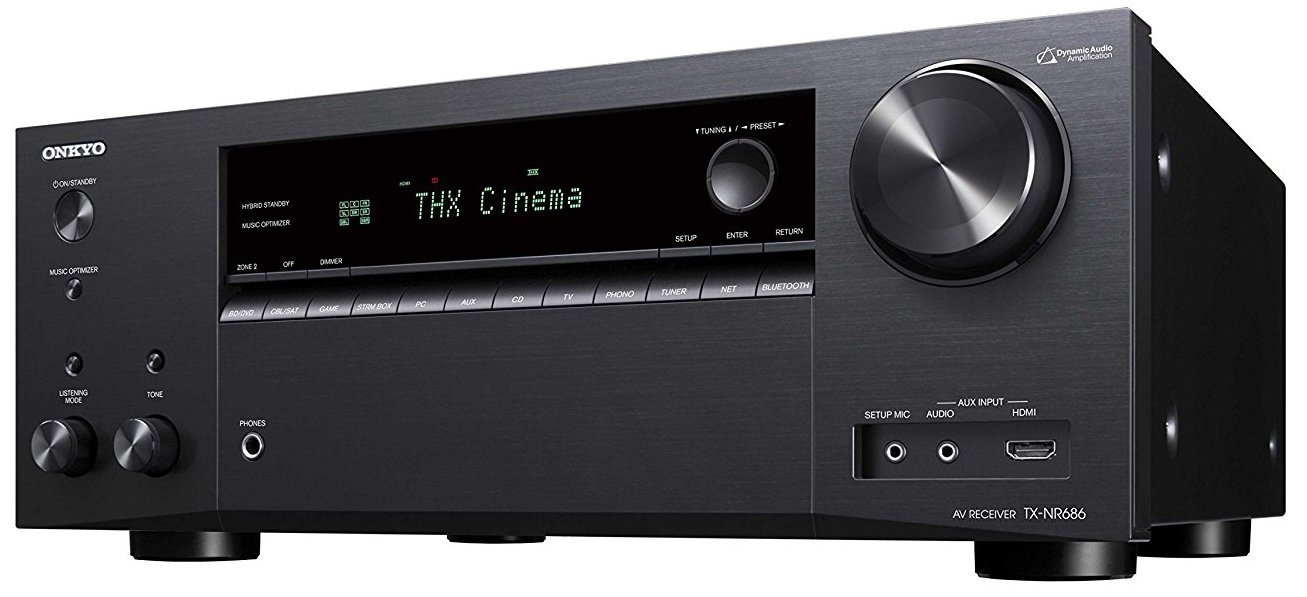 Channels: seven.two
Channels: seven.two
Dolby Atmos: Yes
DTS:X: Aye
Wattage Per Channel: 100/8Ω, Two-Channels Driven
What We Similar: Great range of features for the cost.
What Nosotros Don't: Sound quality isn't super-exciting.
The Onkyo TX-NR686 is an ideal alternative to some of the pricier models above, peculiarly if you don't need the additional channels and power. For almost all setups, this is an excellent choice, boasting a great range of features for the cost. These include the power to add speakers in an additional zone, meaning this could easily power the sound in an entire house. You lot likewise get not one only two subwoofer outputs, meaning that the entire business firm will shake on its foundations.
The problem is that the sound quality isn't nearly equally compact as the Denon AVR-Due south-750H, which actually costs much less Information technology's still very good – yous certainly won't feel shortchanged. But it doesn't accept the punch or excitement other receivers accept, and if you actually desire to feel movies and streaming series in the best possible manner, it'south worth going for the Denon. You lot besides don't get quite as many environs audio options - just Atmos, DTS:10, and DTS Neural:X. Otherwise, this is an excellent choice.
See the Onkyo TX-NR686
14. Denon AVR-X4700H ($2,099)
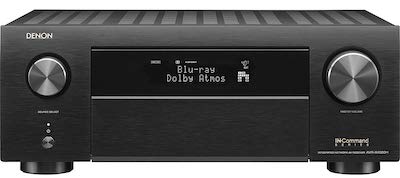 Channels: 9.two
Channels: 9.two
Dolby Atmos: Yes
DTS:X: Yes
Wattage Per Channel: 125/8Ω, Two-Channels Driven
What We Like: Unreal sound quality, near perfect design, enhanced power supplies.
What We Don't: Not ideal for smaller rooms.
The Denon AVR-X4700H is is a punchy, powerful 9.two channel receiver, which tin can not only scale to 11.2, but too delivers a staggering corporeality of applied science for the cost. It easily beats comparable models from Onkyo, Yamaha, and Arcam in both sound quality and characteristic set. Information technology's ane of the best-sounding receivers on this list, and definitely the best sounding in this price range.
Unremarkably, we aren't fans of incremental updates. However, Denon have kept the cost the same as the previous model, while managing to add in some pregnant changes to the circuitry. The AVR-X4700H may have an identical housing to the receiver before it, simply the internals accept been overhauled, including the addition of upgraded power supplies for even cleaner sound. You go everything you'd await, including Dolby Atmos, DTS:X, Amazon Alexa support, Audyssey room correction, and even Auro-3D. Information technology must be said that, if you don't have the greenbacks, this may not be the receiver for you lot – and it's certainly not ideal for smaller rooms. If you're dealing with a smaller infinite, you're meliorate off choosing something like the Sony STR-DN1080.
See the Denon AVR-X4700H
15. Denon AVR-X8500H ($iii,999)
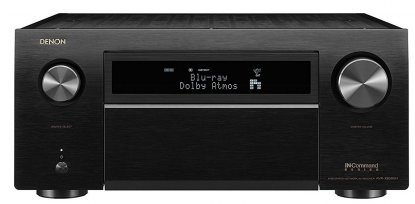 Channels: thirteen.2
Channels: thirteen.2
Dolby Atmos: Yes
DTS:X: Yes
Wattage Per Channel: 150/8Ω, Two-Channels Driven
What We Like: A truly unique receiver.
What We Don't: Most people volition never find a utilise for it.
At a fourth dimension when home audio systems are getting smaller, smarter, and more than compact, Denon decided to go in the reverse direction. They've created this truly stupendous receiver, with 13.2 channels. Yes, yous read that right. That's thirteen.two native - available from the become-go without any boosted preamps. Eight height speakers? Why not?
At the time of writing, there's simply nothing else quite like it. And if you can imagine a type of surround audio programme or a receiver technology, it's here. The feature set is merely unbelievable. Yet, like the Arcam AVR20, this is overkill for most people. It's something that should merely exist bought by those who can take full advantage of its speaker aqueduct complement. Otherwise, yous're just wasting your time. If yous accept a big room and want to experience the joys of something like Auro-3D, then this is nigh definitely the receiver you should go for. Information technology services a niche market, only it does this incredibly well. If you lot want the aforementioned Denon quality, but aren't prepared to pay quite as much (and don't demand as many channels) try the AVR-X3600H. Past the way, this is known as the AVC-X8500H in the UK and Europe, because...actually, we take no idea why. Nosotros've asked Denon for an respond, and volition update when they respond.
Run into the Denon AVR-X8500H
xvi. Arcam AVR20 ($four,400)
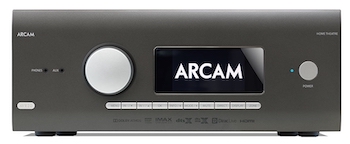 Channels: 9.1.half dozen
Channels: 9.1.half dozen
Dolby Atmos: Yes
DTS:X: Yes
Wattage Per Channel: 110/8Ω, Ii-Channels Driven
What We Similar: Unbelievable sound quality and ability.
What We Don't: Staggering price tag, no Auro-3D.
If you want excellence, and are prepared to pay for it, then you should go talk to the folks at Arcam. They make some incredible sounding and incredibly expensive receivers, of which the AVR20 is the latest. It's stupendous; not simply in terms of sound quality, merely in its unrivaled dedication to larger environment sound setups. If you take a huge listening room, and a great set up of speakers, and then perhaps you can take advantage of the AVR20's 9 channels, forth with its six superlative channels. Were it not for the enormous price, which puts it out of reach for almost people, nosotros recollect the AVR20 would be in the pinnacle spot.
Information technology offers significantly amend audio than the top-ranked NAD T 778, although sound isn't everything.There'southward at least one puzzling omission here, which is Auro-3D. For a $iv,400 receiver with six height channels, you lot'd think the AVR20 would have the capacity to deal with this particular surround sound codec. While this may only be a problem for a minority of listeners, the huge price tag affects everybody looking for receivers, and makes this one unimaginable for the majority. Simply as a high-stop pick, in that location's none meliorate than the Arcam AVR20.
Encounter the Arcam AVR20
17. Pioneer VSX-934 ($479)
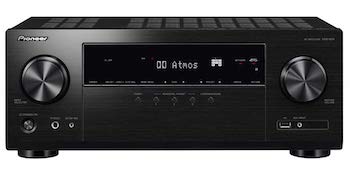 Channels: 7.two
Channels: 7.two
Dolby Atmos: Yeah
DTS:X: Aye
Wattage Per Channel: 160/8Ω, Two-Channels Driven
What We Like: Skillful surround sound for the toll.
What We Don't: Other models offer better sound and functionality.
We consider the Pioneer VSX-934 a proficient alternative to the Sony STR-DN1080, due to information technology's attractive price point and range of features. Chief among these is the inclusion of Apple AirPlay 2. If you lot like streaming wirelessly from your iOS device, and so this could be an fantabulous option for yous. It too delivers superb surround sound with a huge range of codecs bachelor. The sound quality – peculiarly the depression-end – has excellent weight and presence to it. You'll feel every explosion, punch, and bullet impact.
In our testing, we liked this receiver, but it didn't quite knock off the titans in a higher place it. It'due south a very good choice, and felt like it was versatile enough to work in both big and small rooms, but it didn't do annihilation we hadn't already seen before. Call back of it equally a workmanlike receiver, with an acceptable range of features, that yous can count on to become the job done.
Meet the Pioneer VSX-934
xviii. Yamaha RX-V6A ($600)
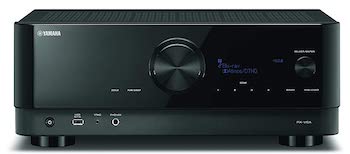 Channels: 7.2
Channels: 7.2
Dolby Atmos: Yes
DTS:X: Yes
Wattage Per Aqueduct: 100/8Ω, Two-Channels Driven
What We Like: Sleek design that is eye-communicable and different.
What We Don't: Exterior of looks, there's little different here from less-expensive models.
Yamaha recently refreshed their entry-level line of receivers, of which the seven.two-channel RX-V6A is one. It has a completely redesigned front-end, which nosotros think looks gorgeous. The sleek, black area and the 2-tier layout is a breath of fresh air amid the identikit black boxes on this list, and we truly promise the design makes it all the style upward the Yamaha line.
Unfortunately, that'south where our recommendations end. Because for $600, nosotros would take hoped that the RX-V6A would do something a piddling unlike, beyond the looks. Yep, you lot get 8K and HDR10+, only there's just not enough content to have advantage of them right now. We can't really recommend y'all purchase this over, for example, the less-expensive Denon AVR-S750H ($499), which is a tried-and-tested car with like features. The RX-V6A should practise amend on this listing if the price drops at whatever signal.
Run into the Yamaha RX-V6A
AV Receiver Comparison Table
As Dolby Atmos and DTS:Ten are the dominant surround audio software programs available, that'due south what we've focused on when comparison AV receivers. If you want a total list of each receiver's surround-sound programs, cheque out the table below for our explanation of lesser-known ones.
| Receiver | Price | Channels | Dolby Atmos | DTS:X | Watt* | Conn.** |
|---|---|---|---|---|---|---|
| Denon AVR-S960H | $850 | 7.2 | Yes | Yeah | 90/8Ω | Blue./Wi-Fi |
| Sony STR-DH590 | $278 | v.ane | No | No | 145/6Ω | Bluetooth |
| Yamaha RX-V485 | $450 | 5.1 | No | No | 80/8Ω | Bluish./Wi-Fi |
| Denon AVR-X3700H | $one,599 | 11.2 | Yes | Yes | 105/8Ω | Blue./Wi-Fi |
| NAD T 778 | $3,199 | 9.ii | Yep | No | 90/8Ω | Blue./Wi-Fi |
| Denon AVR-S750H | $699 | 7.2 | Yes | Yes | 75/8Ω | Bluish./Wi-Fi |
| Integra DRX-3.3 | $999 | 9.two | Yeah | Yes | xc/8Ω | Blue./Wi-Fi |
| Denon AVR-S540BT | $349 | 5.ii | No | No | 70/8Ω | Blue./Wi-Fi |
| Sony STR-DN1080 | $1,013 | 7.2 | Yeah | Aye | Unknown | Blue./Wi-Fi |
| Sony STR-DH790 | $440 | vii.2 | Yes | Yes | 145/6Ω | Blueish./Wi-Fi |
| Marantz NR1711 | $999 | 9.2 | Yes | Yep | 110/8Ω | Blue./Wi-Fi |
| Pioneer SC-LX904 | $ii,999 | 11.2 | Aye | Yes | 140/8Ω | Blueish./Wi-Fi |
| Onkyo TX-NR686 | $700 | 7.two | Yes | Yes | 100/8Ω | Blue./Wi-Fi |
| Denon AVR-X4700H | $2,099 | ix.2 | Yes | Yes | 125/8Ω | Blue./Wi-Fi |
| Denon AVR-X8500H | $three,999 | 13.ii | Yes | Yes | 150/8Ω | Blueish./Wi-Fi |
| Arcam AVR20 | $four,400 | 9.1.6 | Aye | Yeah | 110/8Ω | Blue./Wi-Fi |
| Pioneer VSX-934 | $479 | seven.ii | Yes | Yeah | 160/8Ω | Blue./Wi-Fi |
| Yamaha RX-V6A | $600 | vii.2 | Yes | Yep | 100/8Ω | Blueish./Wi-Fi |
*All wattage ratings are for two channels driven, which is what manufacturers commonly list. If you're running all channels, look the wattage per channel to be a little lower!
**Conn. = Connectivity - whether something has Bluetooth and Wi-Fi.
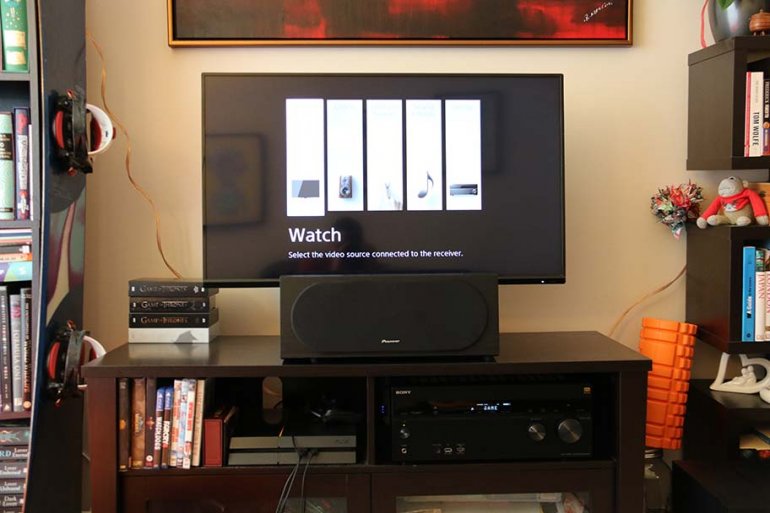
AV Receiver Ownership Advice
- What Does An AV Receiver Do?
- AV Receiver Channels Explained
- Dolby Atmos, DTS:X, and Other Common Surround Sound Software
- Room Size
- Wattage Explained
- HDMI Explained
- 4K Explained
- Bluetooth vs. Wi-Fi
- AV Receivers and Sonos
- Connecting Your AV Receiver
- Room Scale Explained
- AV Receiver Placement Explained
- Smart Receivers: Amazon Alexa and Google Domicile
What Does An AV Receiver Practise?
Got multiple speakers? Planning on a environs system? So you need an AV receiver. We used a quarterback illustration earlier, but perhaps a better one is air-traffic control. A receiver takes all the incoming audio and video signals, and reroutes to them their correct locations on the wing, sending audio out to your speakers and video from your games console (for case) to your TV. If it'due south a good receiver, it will sharpen and improve the signals before sending them on, using its converters and amplifiers to make things ameliorate.
A lot of the picks on this listing don't really look like much. They are fairly dull, banal boxes with a bunch of controls on them, and a bewildering array of inputs and outputs around the back. Merely without this box, your home theater setup is going nowhere. There are a few cardinal components inside each box. There's a preamplifier and an amplifier, for handling audio signals, a set of video inputs to work out where to send the visuals, and a decoder to separate the two. In addition, in that location may be a split up surround sound decoder, which splices the audio into its unlike channels and makes certain they get to the correct speaker. And by the way, it's merely functional if you have speakers to plug into it, or if you've got a full home theater system where the central component needs an upgrade. Expert hunting!
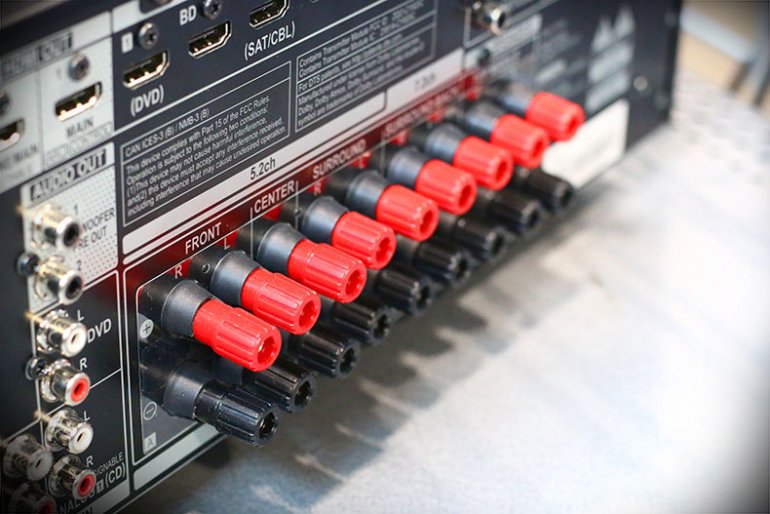
AV Receiver Channels Explained
You've probably noticed the numbers v.1, 7.1, and 9.2 floating around this article. What'due south up with that? Well, this number refers to the corporeality and type of speakers in the setup: the offset (5, 7, nine, whatever) refers to the number of high end and mid range speakers, while the second i (the .1, sometimes .2) refers to the subwoofer, or low-finish speaker. Simply put, the more quality speakers in that location are, the more than rich and dynamic your sound is probable to exist. At the same time, you're probable to pay more the higher those numbers get.
5.1 and 7.1 are considered the standard - the basic number of channels which a given receiver might have. Whatever receiver to a higher place about $500 will most ever offer 7.2 channels, allowing for vii speakers and 2 subwoofers. Fifty-fifty cheaper models, similar the Denon AVR-S750H, come up with 7.ii speaker channels. A five.1 organisation would include 3 forepart channels (a center speaker, designed to sit under your TV, and two bigger ones just off to the left and right), and ii on either side of the listening position. A seven.1 would add together 2 more than, backside you. A 9.i or 11.1 system is where you beginning calculation height speakers - something only a few receivers can really accept, like the incredible Denon AVR-X8500H, which offers a massive thirteen channels. This kind of thing is usually undertaken when you have a large room, and don't mind doing some DIY to mount your speakers! Worth noting: the subwoofer channels (the .i or .2) will require their own power, meaning you'll use a unlike connection to that from your speakers. Nosotros'll go into this in more than detail below. And some receivers, like the cheaper Denon to a higher place, also allow you to aggrandize your channel quota by adding more amps into the mix.
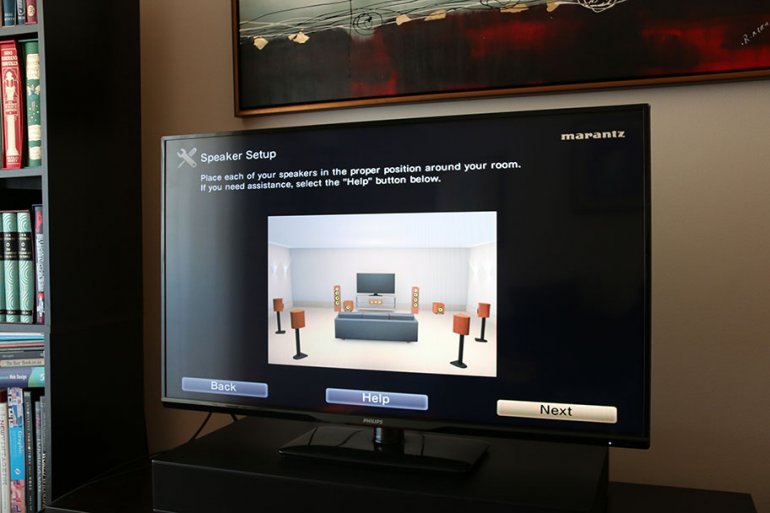
Dolby Atmos, DTS:10, and Other Common Surround Sound Software
Simply put: environs sound aims to deliver multi-dimensional sounds that move around in the same way equally objects would in existent life, by calculation meridian to our aural perception. Surround systems rely on multiple speakers positioned in front of, behind, to the side and, sometimes, in a higher place your listening position. What makes surround sound possible are codecs: software code converting digital ones and zeros into an aural audio. They take the sound beingness sent into your AV receiver, and tell information technology where to become and how to be reproduced. If y'all're not into reading tech specs, you can think of an AV receiver as a telephone, and a environs sound codec as an app on that telephone.
There are many, many surround sound codecs. Some are pieces of legacy software, some accept very specific applications, and some are just there because…nosotros don't know. Hardly anybody has ever used them. While we aren't going to break down every single one (we'd be hither all day, trust usa) it's worth touching on a few - we'll tackle half-dozen of the virtually common ones. You might never need to know what DTS-ES half-dozen.1 Discrete is - honestly, we have to look it up every fourth dimension we come up across it - merely information technology's definitely worth knowing what Dolby Atmos and DTS:X are.
Dolby Atmos
Dolby Atmos is, as far every bit nosotros are concerned, the all-time environment sound bachelor. Where Dolby Atmos differs from conventional environment ready-ups is by necessitating one, 2 or more than actress pairs of ceiling speakers. Such elevated "reflecting" speakers will be positioned higher up your existing floor-level environs speakers, allowing for sounds to move betwixt top and bottom. If starting from scratch, there are many Dolby Atmos enabled packages bachelor to purchase, fix-in-a-box, including everything you need: AV receiver, amplification, and speakers. If you're upgrading an already existing home surround organisation, you lot would need a Dolby Atmos-uniform AV Receiver. The biggest investment, though, would be for the additional elevated speakers - even for a minimal Dolby Atmos setup, you would need at least two ceiling speakers on top of a regular surround set, if not four.
Now yous're probably thinking: really? Drilling holes in my ceiling? Fortunately, the guys who make Dolby are wicked smart, and they've come up with an alternative solution. Instead of installing speakers in or on the ceiling, you can add speakers on top of your existing towers, with drivers projecting upwards. Atmos-enabled speakers tin can come with such drivers already congenital-in, and you tin buy Atmos-modules that volition work with your existing speakers. Worth noting: These boosted up-firing speakers have their own speaker terminals to make them into split up, dedicated channels. This of course increases the number of amp speaker outputs needed - yous might have to invest in additional amplification if you lot've already used up all of your amp's available speaker connections. If you're looking for a adept pair of upwardly-firing Atmos speakers, we recommend the Klipsch RP-500SA (total review here).
Dolby Atmos have their own fashion of naming their height-elevated setups, considering surround sound systems weren't confusing enough already. A 5.1.2 Atmos set-up would be like a traditional v.1 surround organisation (in other words, v speakers and a subwoofer) but with an added pair of ceiling speakers (or Atmos modules): the '2' in five.i.2. Similarly, a 7.1.4 Atmos set volition be like a 7.1 conventional environment setup with two actress pairs of ceiling speakers or Atmos modules (hence the iv in 7.ane.4).
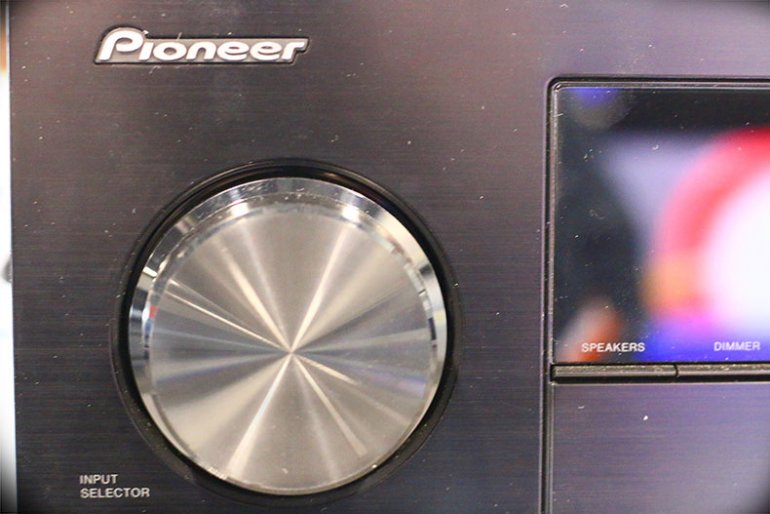
DTS:10
DTS:X is the easiest one out of the lot to integrate within an already existing 5.one or seven.1 surround sound setup, and as such it's perfect for beginners. If you're merely getting started in surroundings sound, and yous already own some speakers or program on getting a bones setup, this is the i to go for. DTS:X's approach to improving the listener's experience is past "freeing the sound content from specific speaker channels" and is purely software based - there are no physical requirements for the number of speakers or their locations when setting up the system. It'll piece of work with any conventional speaker setups, upwards to 32 speakers.
With a DTS:Ten-enabled receiver continued, the residual of the setup is straightforward, really - the auto-scale system optimizes all dialogue and audio furnishings feeds for y'all. The system'south menu besides allows user-definable level adjustment, and can fifty-fifty boost difficult-to-hear dialogue higher up the other sounds. Plus, older format movie and game soundtracks and fifty-fifty stereo music files can all exist played through DTS:X - the conversion (from non-DTS:Ten sources) uplifts the content with an added spatial audio realism. For best results, information technology is recommended that yous play content (Blu-ray discs or streaming Digital Media) optimized for DTS:X.
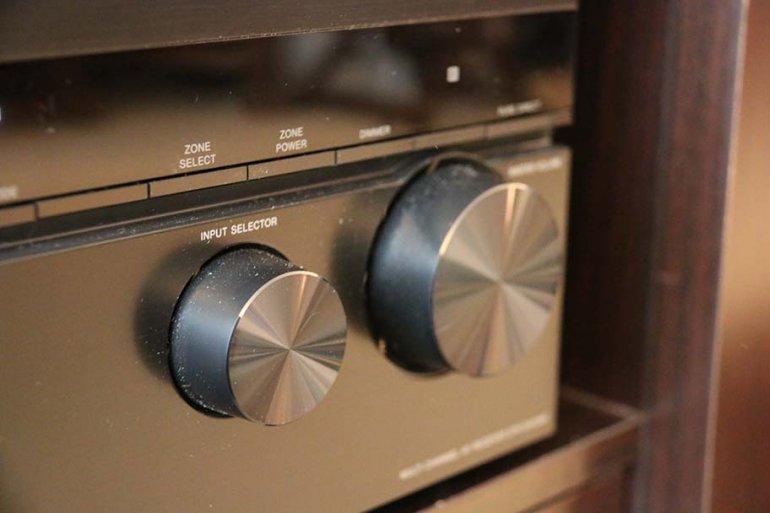
Auro-3D
Auro-3D is kind of a dark horse here. Dolby has a huge market share, and DTS:X is gaining fans fast, but Auro-3D's technological requirements have seen it struggle, despite the fact that it's pretty incredible. It requires two extra height levels added to the conventional surround experience: wall mounted peak speakers installed on the sides, also as a unmarried main ceiling speaker- the awesomely-named Voice Of God speaker. Found in nine.1, xi.ane and 13.1 configurations, Auro-3D is surprisingly flexible. For example, if you are already using a 5.one you can outset your upgrade to an Auro ix.1 setup past adding four wall speakers - 2 above your ii main speakers, and 2 above your 2 surrounds. If upgrading a 7.1 surround fix to an Auro 3D layout you lot'd demand an additional speaker to a higher place each environment and eye speaker plus the added single ceiling aqueduct.
We need to point out that an Auro-3D installation (or an upgrade from a regular environs system) can be a fleck tricky due to the very specific positions, heights and angles of the additional Auro-3D overhead layers and wall speakers. This plays a major part in achieving the best possible audio quality. And unless you're rich enough to have two habitation theater rooms, yous aren't going to exist combining an Atmos organisation with an Auro-3D one. Similarly, Auro-3D won't be happy with multiple ceiling speakers or up-firing drivers. If all that sounds splendid, and so take a look at a receiver like the Denon AVR-X8500H which will allow you lot to upgrade to Auro-3D functionality via a firmware update.
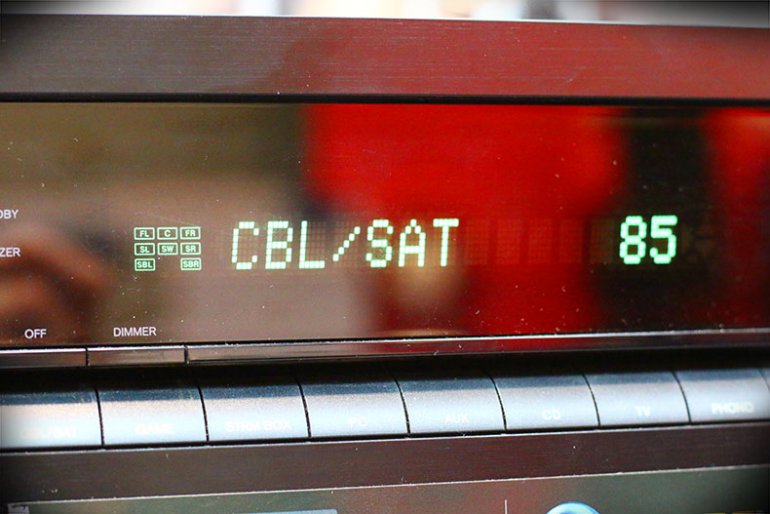
Dolby Truthful HD
Dolby TrueHD is the surround audio plan used when your receiver isn't quite cool enough to have Dolby Atmos. If your source is Atmos-capable – like, for example, a Blu-ray disc – but your receiver isn't, the mix will exist output equally Dolby TrueHD. It's an eight channel mix, which is still skillful, merely not virtually as practiced as Atmos. Information technology's in direct competition with DTS-HD Master Sound. As you lot can imagine, this does much the same matter, merely for sources decoded with the DTS:X format. Essentially, if you see either of these, information technology means that your receiver will yet exist able to take a Dolby Atmos or DTS:10 mix and practise something with it, even if it is incapable of those high-cease environs sound programs.
DTS Neural:X
DTS Neural:X is a niggling bit trickier. Let'southward say y'all have a source that only offers two.1, five.1, or 7.1 audio – in other words, audio that has been mixed for speakers at ear-level. Permit us also say that you have a system with height speakers. That's when DTS Neural:X would kick in, extrapolating height data from the mix, and playing it through those speakers. It's not nearly as efficient as DTS:X, or equally mutual, but information technology's definitely useful in certain circumstances.
Dolby Digital Plus
Finally, allow'south talk nigh Dolby Digital Plus. This is what you lot'll be using if your system doesn't take height speakers, only y'all all the same wish to use a Dolby sound mix. It'south non ever a skilful idea to do this, specially when DTS:Ten it's and then practiced, but some receivers don't have that, and and then Dolby Digital Plus is worth knowing about. Put simply, information technology's the standard non-Atmos Dolby software, and volition give you surround sound without the height elements.
For reference, here is a list of our AV receiver picks, with every environs sound program they offer.
| Receiver | Price | Channels | Surround Sound |
|---|---|---|---|
| Denon AVR-S960H | $650 | 7.2 | Dolby TrueHD, Dolby Atmos, Dolby Atmos Tiptop Virtualization, Dolby Environs, DTS:X, DTS Virtual 10, DTS Hd Master, DTS Neural:X |
| Sony STR-DH590 | $278 | v.1 | Dolby Digital, Dolby Dual Mono, DTS-Hd Primary Audio, DTS-Hd High Resolution Audio, DTS, DTS 96 / 24 |
| Yamaha RX-V485 | $400 | 5.1 | Dolby TrueHD, Dolby Digital Plus, DTS-Hd Master Audio |
| Denon AVR-X3700H | $1,299 | eleven.2 | Dolby TrueHD, Dolby Atmos, Dolby Atmos Height Virtualization, Dolby Surroundings, DTS:X, DTS X Pro, DTS Hard disk Master, DTS Neural:X, DTS Neo:X |
| NAD T 778 | $two,999 | 9.2 | Dolby Atmos, DTS Master Sound |
| Denon AVR-S750H | $577 | 7.2 | Dolby TrueHD, Dolby Atmos, Dolby Atmos Elevation Virtualization, Dolby Surround, DTS HD Main, DTS:10, DTS Neural:10, DTS Virtual:X |
| Integra DRX-3.iii | $999 | 9.2 | Dolby Atmos, Dolby Environment, Dolby Vision, Dolby Atmos Height Virtualization, DTS:X, DTS Neural:X, DTS True-HD |
| Denon AVR-S540BT | $299 | 5.two | Dolby TrueHD, DTS HD Master |
| Sony STR-DN1080 | $598 | 7.2 | Dolby Atmos, Dolby Digital, Dolby Dual Mono, DTS: 10, DTS HD MA, DTS Hard disk HR, DTS, DTS-ES, DTS 96 / 24 |
| Sony STR-DH790 | $448 | 7.2 | Dolby Atmos, Dolby Digital, Dolby Dual Mono, DTS: X, DTS-HD Master Sound, DTS Hard disk High Resolution Sound, DTS, DTS-ES, DTS 96 / 24 |
| Marantz NR1711 | $849 | nine.2 | Dolby Atmos, Dolby Surroundings, Dolby True Hard disk, Dolby Height Virtualization, DTS:Ten, DTS HD Master, DTS Neural:X, DTS Virtual:X |
| Pioneer SC-LX904 | $2,999 | 11.two | Dolby Atmos, Dolby Surround, Dolby Atmos Summit Virtualization,Dolby TrueHD, Dolby Digital Plus, DTS:X, DTS Neural:10, DTS-Hard disk drive Principal Audio, DTS-HD Loftier Resolution Audio, DTS 96/24, DTS-ES, DTS Express |
| Onkyo TX-NR686 | $700 | 7.ii | DTS:X, DTS Neural:X, Dolby Atmos |
| Denon AVR-X4700H | $ane,799 | 9.2 | Dolby Atmos, Dolby TrueHD, Dolby Surround, DTS Hard disk drive Master, DTS:X, DTS Neural:X, DTS Neo:X, Auro-3D |
| Denon AVR-X8500H | $3,999 | xiii.2 | Dolby Atmos, Dolby TrueHD, Dolby Surround, DTS Hard disk Master, DTS:X, DTS Neural:X, Auro-3D |
| Arcam AVR20 | $4,000 | 9.1.6 | Dolby Atmos, DTS:10 |
| Pioneer VSX-934 | $479 | 7.2 | Dolby TrueHD, Dolby Digital Plus, DTS Virtual:X, DTS Neural:X, DTS-HD Master Audio |
| Yamaha RX-V6A | $600 | 7.2 | Dolby Atmos, Dolby Surround, Dolby Digital Plus, Dolby True Hard disk drive, Dolby Height Virtualization (via futurity update), DTS:Ten, DTS HD Master |
Room Size
One of the near common questions we become via electronic mail is what nosotros mean when we refer to big, medium, and minor rooms. We'll admit: in the past, nosotros oasis't always been clear about what this means. Part of this is considering information technology's really quite difficult to define – later on all, how long is a piece of string? And despite having standards for but virtually every aspect of a piece of equipment imaginable, the dwelling theater industry has yet to quantify room size. Given how important it is to take into business relationship the size of your room when choosing an AV receiver, that's probably not a proficient thing. Then let's settle this once and for all. Acquit in mind that this is our accept on it, and should be used more as a guideline than anything else.
A pocket-sized habitation theater room should be considered anything with floorspace upwards to 130 square feet, whereas a medium room is upwardly to 250 square feet, and a big room is anything to a higher place 250 square feet. We got those figures by chatting to our contacts at home theater companies. While none of them had a definitive answer, it was piece of cake to get an average from their responses. You'll notice that nosotros've gone for square feet and floor space, rather than cubic anxiety and total room volume. While the volume of your room does have an impact on the sound, we think that, as long as your ceilings are at to the lowest degree eight feet high, you'll be fine. You don't desire to get above 12 feet, generally speaking. It's besides worth noting that a home theater room should, ideally, be rectangular with the organization projecting out from i of the brusk ends. Nosotros appreciate this isn't always achievable, specially if you live in a small-scale apartment, but ultimately, you've got to work with what you have.
You lot could argue that our approach is unscientific, but we believe these guidelines will hold truthful for the majority of people. For case, it's pretty clear that our the $1,499 Marantz SR6014 will be all-time suited for rooms above 250 square feet, thanks to its large power output. Any space smaller than that but won't get the best from your receiver. And given that the SR6014 costs $one,499 at the time of writing, you actually want to go the all-time out of information technology.
Wattage Explained
This is the amount of power that the amp will push button through to your speakers, and it can be as low as 30 watts (Due west) and as loftier as 500 watts. Yous'll demand to brand sure your speakers can actually accept this level of power, and again, there's no point paying for power that is going to be overkill in the room (or which isn't going to fill information technology up enough of it). You lot need to await at the wattage, which will give yous an idea of how powerful your sound is going to be. We spent some fourth dimension thinking most which stat to list here, and in the end, you'll see that for most of our amps, nosotros listing wattage for two channels driven - two channels beingness the minimum (we think) that a receiver takes.
The first thing you might be wondering is: if a receiver is 7.ii, then why are they being rated for two channels of sound? That, my friend, is because the two channel ratings look amend than the seven channel ones, which are considerably lower. Even so, about all receivers will be able to evangelize plenty power, and then don't stress near it besides much. It's more important to friction match speakers well, and you can do that past looking at output specs. Here's an case of a typical manufacturer stat: Rated Output Power (20Hz-20kHz, 2ch driven): 105 W (eight ohms, 0.08% THD). That's for the Denon AVR-X3700H, and what it means is that when two channels are receiving power with viii ohms of electric resistance, between the ranges of 20Hz and 20kHz, you lot'll be getting seventy-5 watts of power with around 0.08% of distortion. And if that was gobbledegook, the only affair you lot need to pay attention to is the bit that says 'seventy-five watts of power'. Find a speaker that tin take that particular wattage at eight ohms, and you're good to go. We explicate information technology in a lot more particular here - don't worry, it's easy!
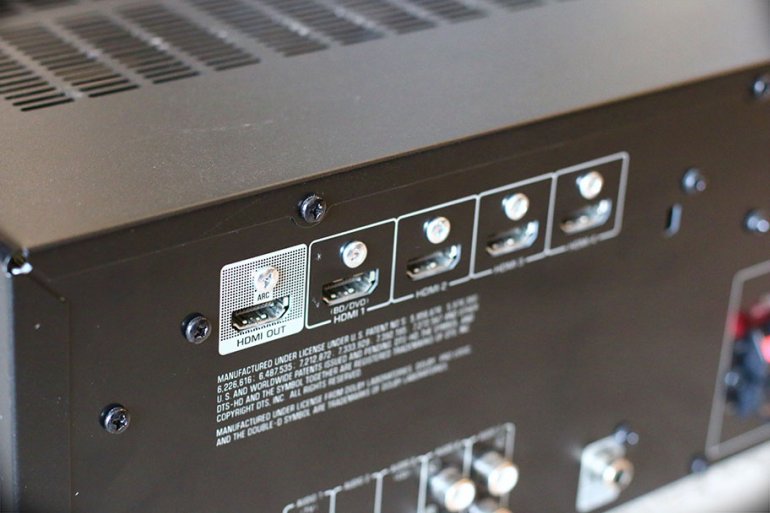
HDMI Explained
There are a huge number of connections on the back of whatever given receiver unit, both analog and digital, and we could spend quite a while going into swell detail of which ones you'll need. By far the virtually important ones are the HDMI inputs. Y'all'll want at least a few of these, as information technology'due south the well-nigh-common and about-utilized type of port.
When nosotros say HDMI I/O, we mean HDMI Inputs/Outputs. Unremarkably, there are more of the former than the latter, and depending on how many HDMI-capable gadgets yous have, this detail could be super important. Only practice you lot really demand all seven HDMI ports? For well-nigh of usa, three or iv will be more enough. So why are yous going for a unit that has more than double what you need? You call up those things come for complimentary? No way. Y'all pay for extra ports, and so recollect advisedly about how many pieces of equipment y'all're going to be using before you vanquish out your hard-earned cash. But on the other hand, these pieces of tech last for quite a while, and you lot will probably own yours for years. Over those years, you lot'll certainly collect new electronics, new gizmos, new devices...all of which volition need a discrete HDMI port. Really, what y'all're going for here is a balance: the number of ports y'all'll use now, plus one or 2 reserved for the future.
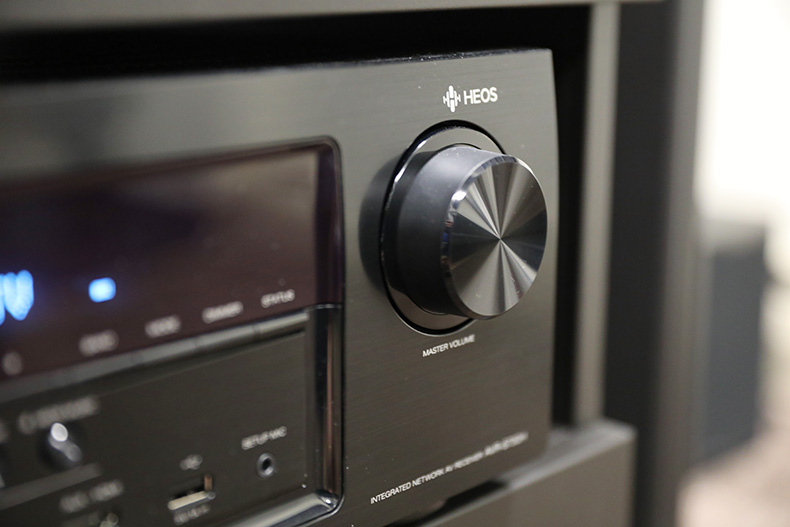
It's an exciting time for HDMI at the moment - as much every bit you can accredit excitement to a cable connectedness. HDMI 2.1 is slowly coming into functioning. This is a very good thing, equally information technology allows the transmission of ultra high quality video, including resolutions upwardly to 10K. Information technology'south specially important if y'all're a gamer, as HDMI 2.1 is capable of transmitting 120 frames per second, meaning y'all get silky shine graphics. The best function is that the physical connectors are exactly the aforementioned – all that's changed is the internals on the cable. At the moment, there are very few receivers and sources that really transmit HDMI two.1 signals, which means information technology will be a while before the upgrade makes a real impression. Withal, there's no question that it'southward the direction we're headed in. Manufacturers similar Yamaha are throwing everything they have into releasing HDMI 2.i receivers.
4K Explained
4K, if you don't already know, is a standard of content with ridiculous visual fidelity and color sharpness. It sounds tricky, but all this number describes is a picture size: iii,840 by 2,160 pixels, to be precise. Information technology means that, no matter how big your actual Television receiver, there volition be three,840 by 2,160 pixels packed onto it, making for a clearer picture. 4K is what a lot of receiver makers ready their reputations by these days, and it's the thing you'll see featured nearly prominently. But several other receivers, like the Denon AVR-S750H, offer support for unlike video standards. It's probably a fleck much for our purposes to go into here, but we do offer an explanation of the unlike types of video in our roundup of the all-time Blu-ray players.
Fifty-fifty though there are enough of 4K-prepare TVs - and then many bits of AV gear exist these days that you might fool yourself into thinking it's something y'all need to have - the truth is that 4K is not yet a necessity. The main issue is that not enough content is produced in 4K yet, pregnant most of what you lot'll see has been 'upscaled' and translated to a 4K setting without actually being 4K. Sometimes it works, sometimes it doesn't. The skilful news is that all the picks on our list are 4K-ready. Even if you lot couldn't care less, yous're getting it anyhow.
You'll notice that we discuss only 4K hither and not 8K. 8K content is, as y'all can imagine, significantly more than visually detailed than 4K, at 8,192 10 4,320 pixels. But while manufacturers might be trumpeting it as the next big affair, the reality is that it has yet to make serious inroads into the earth of home theater. There is almost no 8K content available still, and until the widespread implementation of things like HDMI ii.1, that'due south unlikely to change. For now, you shouldn't buy a receiver based on whether or not information technology tin handle 8K content, every bit you're unlikely to find many movies or seri es you can watch at that resolution.
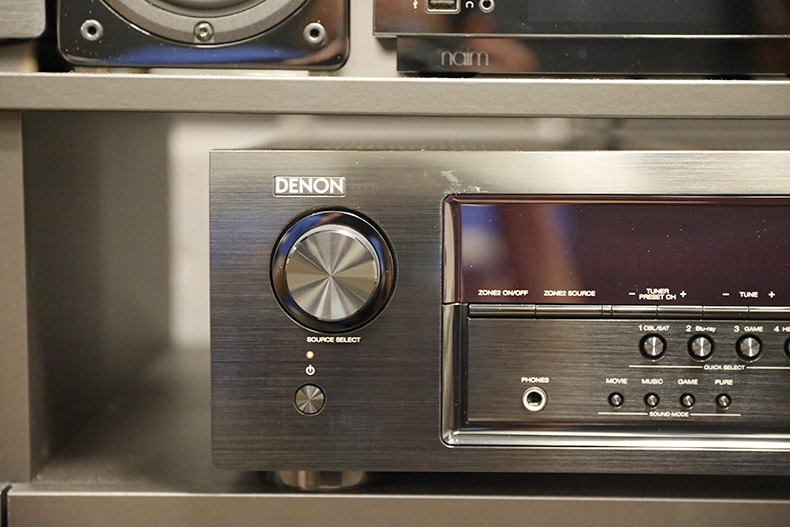
Bluetooth vs. Wi-Fi
Something new to many AV receivers in the last few years is the advent of Bluetooth and Wi-Fi. Long may it continue! Bluetooth streaming allows you to ship audio from your phone or tablet out to your receiver, to be played by your surround speakers. It is piece of cake and convenient, but fifty-fifty at higher encoding levels (similar aptX, or Bluetooth iv.ane, which let more information to exist sent faster) information technology isn't a patch on wired sound, which is always going to exist meliorate.
Wi-Fi, on the other mitt, is giving speaker wire a run for its money. Connecting a receiver to your habitation Wi-Fi network means you lot can play music or video from anything else connected to information technology, like your PC. It's also less prone to dropouts than Bluetooth, and as we mentioned, it sounds better. The downside? It adds another device onto your home network, which we're betting is probably already crawling with devices. One nifty Wi-Fi play tricks: some manufacturers, like Denon, have fabricated their receivers compatible with their wireless multiroom speakers. That means you lot can gear up complex wireless systems that allow yous complete control of your music.
AV Receivers and Sonos
If you lot use any Sonos wireless speakers, you already are aware of simply how simple they are to setup and utilise. For the most part, Sonos has kept this technology to themselves, which meant that those with traditional home theater systems have had to rely on inferior connectivity software. Fortunately, that's changing. Sonos recently unveiled a collaboration with Onkyo and Pioneer that volition allow their outstanding tech to piece of work with certain AV receivers.
What does that mean in practice? You'll be able to control receiver volume past using the brilliant Sonos app, and y'all tin can also attach up to three Sonos Port devices to your receiver. That means you lot can stream any receiver sound directly to other Sonos speakers and subwoofers, which essentially allows y'all to build a full abode theater organisation that incorporates wireless Sonos audio.
That's a massive leap forwards, and it could make designing a surround sound setup much easier. Correct now, however, only a few receiver models have this functionality, although you tin look many more than to include it in the coming months. Of the models that apply Sonos, we remember the $999 Integra DRX-3.iii is the best i currently available, so check that out if you'd like to experience the simplicity of the Sonos ecosystem.
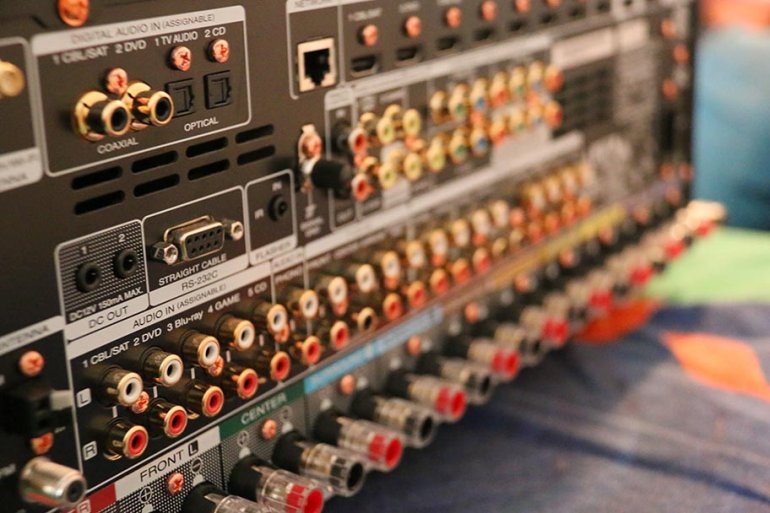
Connecting Your AV Receiver
We actually have a total guide to this, explaining every unmarried connection on that crazy-complicated rear of your receiver, and what to do with it. But here's a very brusque version, if all y'all need is a quick reference. Information technology covers one of the more than common setups.
- Connect your Blu-ray player or console to one of your receiver'due south HDMI In ports, using an HDMI cable.
- Using speaker wire of at to the lowest degree 16-gauge, connect your speakers to their private channels. You exercise this by unscrewing the cap, and threading your stripped wire through the hole so the metallic wire makes contact with the metal speaker port. So screw the cap dorsum on.
- Each speaker has a red (+) connexion, and a black (-) connectedness. Black to black, red to red. E'er. A sharpie to color in the correct dissever on the wire may be helpful.
- Connect your subwoofer to the Pre Out port, using a standard RCA cable.
- Connect your TV to the receiver's HDMI Out port, using a standard HDMI cablevision.
- Plug in the receiver and subwoofer. Yes, nosotros put this final for a reason. DO NOT DO ANY CONNECTING WITH YOUR RECEIVER PLUGGED IN. Ever.
- Plow on your Goggle box and receiver. Switch to the relevant HDMI input using your Television remote. Follow the on-screen setup instructions.
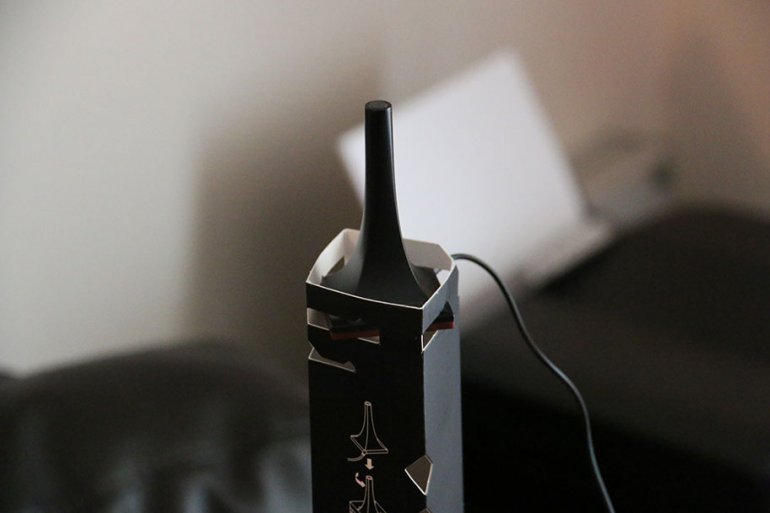
Room Scale Explained
Yous don't play your music or movies in a vacuum. Your sound comes out in a room filled with objects: couches, tables, bookshelves, children, the dog, glass windows, pictures on the walls. All of these things affect the sound. Calibrating your room involves playing a test tone and and so recapturing it through a special microphone before adjusting the sound accordingly. It's a crucial office of the whole dwelling house theater experience, and will assistance y'all become the best out of your receiver, and indeed your whole organization. Non every unit utilizes this type of technology, but we ofttimes find it to exist a peachy bonus. Most receivers with room calibration technology will usually include very detailed instructions on how to set information technology up, and so information technology'due south often a fairly straightforward process. And we highly recommend doing then, if yous tin. The receiver with the all-time room scale on our list is the Denon AVR-X8500H, which has astounding intelligence.
Currently, the best room calibration software is known equally Anthem ARC Genesis. It'due south the latest version of Anthem's ARC software, and includes some pregnant improvements. Information technology now works on both Windows and Mac, and offers not only supreme room correction, but a variety of customizations. When given the option, you lot tin be as detailed as you want with your calibration. If you're interested in making the room sound proficient, then we recommend ARC Genesis – or at the very to the lowest degree, another class of reputable room correction software.
AV Receiver Placement Explained
Something we saw far more than often than we'd like: someone placing their AV receiver in a crowded TV cabinet. Do not do this. AV receivers can get actually hot - particularly after a few hours of operation. It won't catch burn, but it may shut downwards, and you're definitely shortening its lifespan. Give it some room. 2 inches (at least) on the top, sides and rear should be more than plenty to permit air to circulate.
Only - nosotros hear you say - it'southward an ugly machine! I desire to hide it abroad! We get it. Receivers aren't pretty, even at the top stop of the price ranges. But hiding them away causes more than issues than it solves, as information technology too means yous may not be able to use your remote. If you lot take to put information technology in a cabinet, make sure it at least has plenty infinite. Yous could also invest in a remote extender, which ways you lot don't need line-of-site to the receiver to control it. A amend option would be to place the receiver in an open-confront cabinet, or on the flooring out of the way. Any you choose, merely make sure you give it a little room, yes?
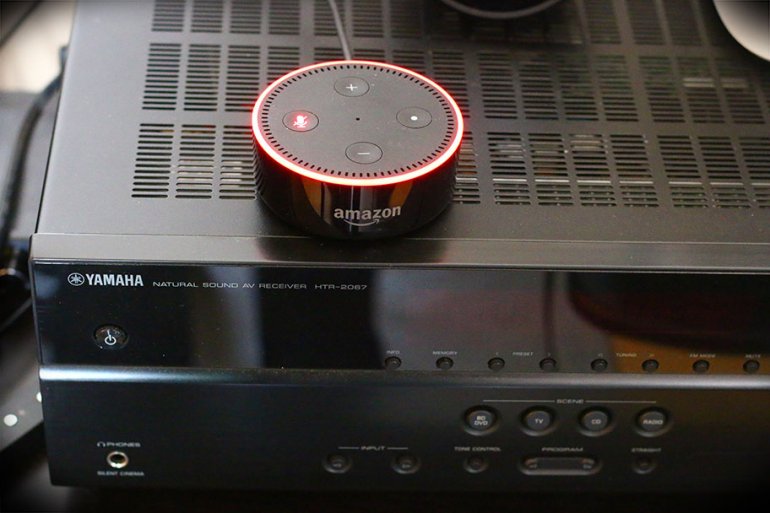
Smart Receivers: Amazon Alexa and Google Home
Receivers are, for the most part, big, clunky workhorses - it'southward ordinarily a struggle to go manufacturers to include technology that the rest of the audio world is already enjoying. Case in point: smart command. Yous might be able to tell Alexa to lower the volume on your Sonos One speaker, just good luck doing it with your home theater system. OK - that'south not quite fair. There are several receivers on our listing which do include smart speaker control, usually using Amazon'southward Alexa software. That means you lot will, in fact, be able to heighten and lower volume, interruption playback, and even adapt inputs merely by speaking loudly from your couch. Unfortunately, at the time of writing, it's non nearly as simple or straightforward every bit it could exist. For one, none of the receivers on our list have native Alexa integration – the virtual assistant isn't actually installed on any of their systems. To use an banana, you lot'll need to connect your receiver to a uniform smart speaker, like an Amazon Echo Spot or a Google Home.
We won't get into how to do that here – the methods differ between manufacturers – but the upshot of information technology is that y'all need your receiver and your smart speaker to be on the same Wi-Fi network. Connecting them shouldn't be that tricky, just you practice demand to exist aware of the limitations of using them. For instance, y'all may struggle to effect vocalism commands while a film or a series is playing at top volume. Ultimately, at this point, you lot shouldn't allow smart speaker integration sway yous when deciding to buy a receiver. It's nice to accept, and tin can be helpful, but it's often far more than effective to simply use the included remote to get the chore washed – peculiarly for everyday things like changing the volume or muting playback.
Back To Our AV Receiver Picks Back To Our Comparing Table
Source: https://www.themasterswitch.com/best-av-receivers

0 Response to "Av Receivers That Are Easy to Set Up"
ارسال یک نظر